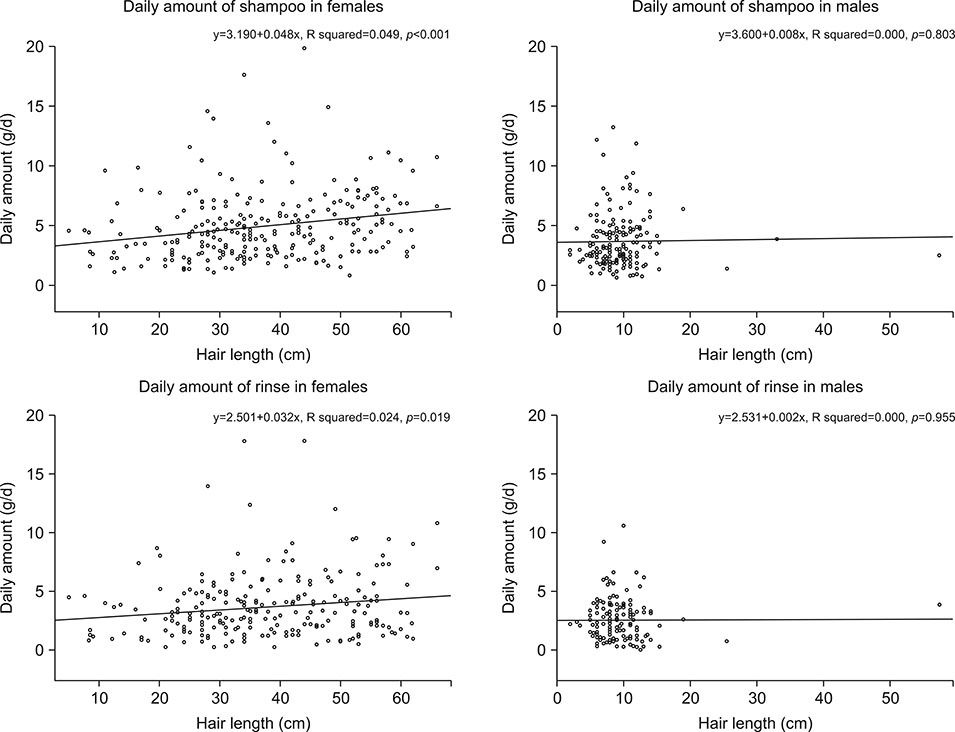Ann Dermatol.
2019 Jun;31(3):307-314. 10.5021/ad.2019.31.3.307.
The Relationship between Epidemiologic Factors and Usage Pattern of Hair Care Products in Korea
- Affiliations
-
- 1Department of Dermatology, Kyungpook National University School of Medicine, Daegu, Korea.
- 2Department of Dermatology, College of Medicine, Dankook University, Cheonan, Korea. ivymyung@dankook.ac.kr
- 3Skin Research Institute, IEC Korea, Suwon, Korea.
- 4Data Computational Sciences, Division of Applied Mathematical Sciences, College of Science and Technology, Korea University, Sejong, Korea.
- 5Department of Pharmacy, College of Pharmacy, Dankook University, Cheonan, Korea.
- 6Department of Dermatology, Dongtan Sacred Heart Hospital, Hallym University College of Medicine, Hwaseong, Korea.
- 7Department of Biomedical Engineering, College of Medicine, Dankook University, Cheonan, Korea.
- KMID: 2444863
- DOI: http://doi.org/10.5021/ad.2019.31.3.307
Abstract
- BACKGROUND
For hair care products that are used almost everyday, it is important to estimate the cumulative dosage of long-term exposure and to assess the effects on the human body. Little data are available to evaluate actual daily usage in Asian populations.
OBJECTIVE
Reliable exposure data for hair care products is essential to conduct safety assessments.
METHODS
We evaluated the actual usage pattern and amounts by checking the daily log over a 2-week period, to obtain all the data regarding the participants' hair care preferences. And, statistical analyses were conducted to analyze the daily use amount (g/d) and daily usage per hair length (g/cm/d), and other variables by sex, age group, and hair oiliness.
RESULTS
Throughout this study, we found that female users consumed significantly larger daily amounts of shampoo and rinse. Male groups used more hair gel and spray than female groups. Interestingly, all the hair care products studied scored higher levels of usage among men when calibrated per unit length. Koreans tend to use lesser amount of rinse although their hairs are usually thicker than the Western hairs.
CONCLUSION
This study provides exposure information for commonly used hair care products, which will be useful for risk assessment purposes.
MeSH Terms
Figure
Reference
-
1. Van Engelen JG, Heinemeyer G, Rodriguez C. Consumer exposure scenarios: development, challenges and possible solutions. J Expo Sci Environ Epidemiol. 2007; 17:Suppl 1. S26–S33.
Article2. Loretz L, Api AM, Barraj L, Burdick J, Davis de A, Dressler W, et al. Exposure data for personal care products: hairspray, spray perfume, liquid foundation, shampoo, body wash, and solid antiperspirant. Food Chem Toxicol. 2006; 44:2008–2018.
Article3. Loretz LJ, Api AM, Babcock L, Barraj LM, Burdick J, Cater KC, et al. Exposure data for cosmetic products: facial cleanser, hair conditioner, and eye shadow. Food Chem Toxicol. 2008; 46:1516–1524.
Article4. Wu XM, Bennett DH, Ritz B, Cassady DL, Lee K, Hertz-Picciotto I. Usage pattern of personal care products in California households. Food Chem Toxicol. 2010; 48:3109–3119.
Article5. Biesterbos JW, Dudzina T, Delmaar CJ, Bakker MI, Russel FG, von Goetz N, et al. Usage patterns of personal care products: important factors for exposure assessment. Food Chem Toxicol. 2013; 55:8–17.
Article6. Hall B, Tozer S, Safford B, Coroama M, Steiling W, Leneveu-Duchemin MC, et al. European consumer exposure to cosmetic products, a framework for conducting population exposure assessments. Food Chem Toxicol. 2007; 45:2097–2108.
Article7. Hall B, Steiling W, Safford B, Coroama M, Tozer S, Firmani C, et al. European consumer exposure to cosmetic products, a framework for conducting population exposure assessments Part 2. Food Chem Toxicol. 2011; 49:408–422.
Article8. Ficheux AS, Bernard A, Chevillotte G, Dornic N, Roudot AC. Probabilistic assessment of exposure to hair cosmetic products by the French population. Food Chem Toxicol. 2016; 92:205–216.
Article9. Ficheux AS, Wesolek N, Chevillotte G, Roudot AC. Consumption of cosmetic products by the French population. First part: frequency data. Food Chem Toxicol. 2015; 78:159–169.
Article10. Ficheux AS, Chevillotte G, Wesolek N, Morisset T, Dornic N, Bernard A, et al. Consumption of cosmetic products by the French population second part: amount data. Food Chem Toxicol. 2016; 90:130–141.
Article11. Dornic N, Ficheux AS, Roudot AC. Consumption of cosmetic products by the French population. Third part: product exposure amount. Food Chem Toxicol. 2017; 106:209–222.
Article12. Park JY, Lee K, Hwang Y, Kim JH. Determining the exposure factors of personal and home care products for exposure assessment. Food Chem Toxicol. 2015; 77:105–110.
Article13. Nohynek GJ, Antignac E, Re T, Toutain H. Safety assessment of personal care products/cosmetics and their ingredients. Toxicol Appl Pharmacol. 2010; 243:239–259.
Article14. Zaleski RT, Egeghy PP, Hakkinen PJ. Exploring global exposure factors resources for use in consumer exposure assessments. Int J Environ Res Public Health. 2016; 13:E744.
Article15. Bennett DH, Wu XM, Teague CH, Lee K, Cassady DL, Ritz B, et al. Passive sampling methods to determine household and personal care product use. J Expo Sci Environ Epidemiol. 2012; 22:148–160.
Article16. Gomez-Berrada MP, Ficheux AS, Dahmoul Z, Roudot AC, Ferret PJ. Exposure assessment of family cosmetic products dedicated to babies, children and adults. Food Chem Toxicol. 2017; 103:56–65.
Article17. Gomez-Berrada MP, Ficheux AS, Galonnier M, Rolfo JE, Rielland A, Guillou S, et al. Influence of the container on the consumption of cosmetic products. Food Chem Toxicol. 2017; 109:230–236.
Article18. Mirmirani P. Hormonal changes in menopause: do they contribute to a ‘midlife hair crisis’ in women? Br J Dermatol. 2011; 165:Suppl 3. 7–11.
Article
- Full Text Links
- Actions
-
Cited
- CITED
-
- Close
- Share
- Similar articles
-
- Relationship between the use of hair products and urine benzophenone-3: the Korean National Environmental Health Survey (KoNEHS) cycle 4
- Four Cases of Hair Shaft Breakage Caused by Hair Care Cosmetics
- A Survey of the Awareness, Knowledge and Behavior of Hair Dye Use in a Korean Population with Gray Hair
- An E-mail Survey of General Awareness and Usage Status of Topical Minoxidil Solution in Alopecia Patient
- Quality of Life and Economic Burden Assessment in Korean Patients with Male and Female Pattern Hair Loss




